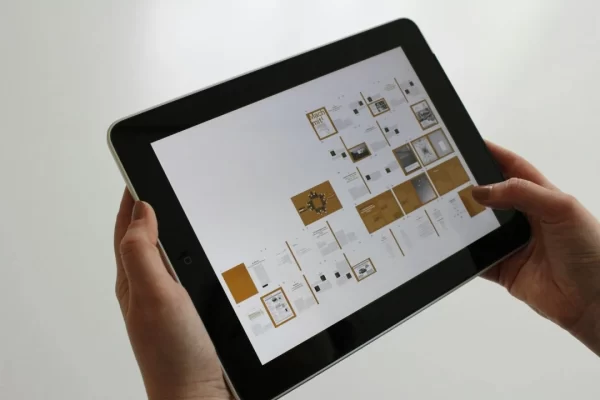Staying ahead as a web designer means constantly evolving and embracing the latest technologies. One of the most transformative shifts today is AI integration in modern web design, which is reshaping how websites are created, maintained, and experienced. From automating repetitive tasks to enhancing user experience through personalisation, artificial intelligence is no longer just a buzzword—it’s a game-changer. This blog explores how web designers can thrive in the age of AI by adopting smart tools and evolving their skill sets.
Whether you’re a freelance designer or part of a digital agency, understanding how to integrate AI into your workflow is essential for staying competitive and delivering innovative, high-performing websites. Read on to discover how to stay relevant and harness the full potential of AI in your design process.
Key Takeaways: AI in Web Design
- AI is revolutionising web design by automating tasks, enhancing personalisation, and optimising user experience.
- Artificial Intelligence tools, including machine learning, NLP, and advanced analytics, help designers work faster and smarter.
- AI-powered platforms like Wix ADI and Adobe Sensei offer automated website creation, intelligent design suggestions, and content optimisation.
- Designers must evolve, combining AI integration with human creativity, storytelling, and interpersonal skills to remain competitive.
- Efficiency, accuracy, accessibility, and scalability are just a few of the major benefits AI brings to modern web design workflows.
- AI does not replace designers—it empowers them to focus on creativity and strategy while AI handles repetitive or data-driven tasks.
Table of Contents
- Key Takeaways
- What is AI in Web Design and How Does it Work?
- Key Features of AI in Web Design
- Benefits of Using AI in Web Design
- Essential AI Skills for Modern Web Designers
- Conclusion: Shaping the Future of Web Design With AI
- Frequently Asked Questions (FAQ)
What is AI in Web Design and How Does it Work?
Artificial Intelligence (AI) is significantly transforming the web design industry, bringing innovative tools and techniques to enhance the design process and improve user experiences. AI in web design involves the application of intelligent systems to automate, personalise, and optimise various aspects of website creation and maintenance.
What is AI in Web Design?
AI in web design refers to the use of advanced technologies, such as machine learning, natural language processing, and data analytics, to improve website efficiency, creativity, and functionality. These AI-driven systems can perform tasks traditionally handled by human designers and developers, offering a blend of automation and intelligent decision-making.
How Does AI Work in Web Design?
AI in web design operates through a combination of data analysis, machine learning, and automation. Here’s a closer look at how these components work together:
Data Collection and Analysis
- AI systems collect data from various sources, including user interactions, website analytics, and social media. This data is then analysed to identify patterns, preferences, and behaviours, which inform the AI’s decisions and recommendations.
Machine Learning Algorithms
- Machine learning algorithms enable AI systems to learn and improve over time. These algorithms can predict future trends by processing historical data and feedback, suggesting design improvements, and personalising user experiences. For example, an AI system might learn that users prefer a particular layout or colour scheme and then recommend similar designs for future projects.
Automation
- AI automates repetitive and time-consuming tasks, such as coding, content generation, and data analysis. This automation not only speeds up the web design process but also reduces the likelihood of human error, ensuring a higher quality and more consistent output.
Natural Language Processing (NLP)
- NLP allows AI to understand and generate human language. In web design, NLP can be used to create conversational interfaces, such as chatbots, and to generate written content that is coherent and engaging.
Key Features of AI in Web Design
AI offers features that transform how websites are created and managed, from automated website builders to advanced analytics. Let’s explore the key features driving this transformation.
Automated Website Builders
- AI-powered website builders like Wix ADI and Bookmark’s AIDA leverage algorithms to help users create websites without needing coding skills. These platforms ask users about their preferences and requirements, then automatically generate a tailored website based on the responses.
Personalised User Experiences
- AI can track and analyse user behaviour to deliver personalised content and recommendations. For example, e-commerce sites can use AI to suggest products based on a user’s browsing history and preferences, enhancing the shopping experience and increasing conversion rates.
Design and Layout Optimisation
- AI tools can assist designers by suggesting optimal colour schemes, layouts, and typography based on current design trends and user data. Tools like Adobe Sensei utilise AI to provide intelligent recommendations and automate repetitive design tasks, streamlining the creative process.
Content Generation and Optimisation
- AI can generate engaging and SEO-friendly content, including blog posts, product descriptions, and multimedia. Natural language processing (NLP) algorithms enable AI systems to create coherent and relevant text while also optimising existing content to improve search engine rankings and user engagement.
Advanced Analytics
- AI-driven analytics tools analyse vast amounts of data to offer insights into user behaviour, website performance, and areas for improvement. These insights enable designers and developers to make data-driven decisions, enhancing the overall user experience.
Chatbots and Virtual Assistants
- AI-powered chatbots provide real-time customer support, handle queries, guide users through the site, and assist with transactions. These intelligent agents can improve customer service and engagement by offering instant, personalised responses.
Benefits of Using AI in Web Design
AI is revolutionising web design by offering many benefits that enhance efficiency, creativity, and user engagement. By integrating AI technologies, web designers can create more dynamic, personalised, and effective websites. Here are some of the key benefits of using AI in web design:
Efficiency and Speed
- One of the most significant advantages of AI in web design is the efficiency and speed it brings to the development process. AI automates repetitive and time-consuming tasks such as coding, content generation, and data analysis, allowing designers to focus on more strategic and creative aspects of their work. Automated website builders, like Wix ADI and Bookmark’s AIDA, can quickly generate customised websites based on user inputs, drastically reducing the time required to launch a new site.
Personalisation
- AI excels at analysing user behaviour and preferences, which allows for delivering highly personalised content and experiences. By tracking how users interact with a website, AI systems can recommend products, articles, or services most relevant to each individual. This level of personalisation enhances user engagement and leads to higher conversion rates, as visitors are more likely to find what they are looking for and take action.
Optimisation
- AI-powered advanced analytics provide deep insights into user behaviour, website performance, and conversion metrics. These insights enable designers and developers to make data-driven decisions to optimise the user experience. For instance, AI can identify the most effective design elements, allowing for continuous improvement of the website’s layout and functionality. This optimisation ensures that websites are visually appealing and perform well in terms of user retention and engagement.
Enhanced User Experience
- AI contributes to a superior user experience by creating more intuitive and user-friendly interfaces. AI tools can suggest optimal design elements such as layouts, colour schemes, and typography based on user preferences and current design trends. Additionally, AI-powered chatbots and virtual assistants provide real-time customer support, answer queries, guide users through processes, and even assist with transactions. These intelligent agents enhance user satisfaction by offering instant, personalised assistance.
Content Generation and SEO
- AI is also a powerful tool for content generation and search engine optimisation (SEO). Natural language processing algorithms can create high-quality, engaging, and SEO-friendly content, such as blog posts and product descriptions. AI can also analyse and optimise existing content to improve its relevance and performance in search engine rankings. This capability ensures that websites attract more traffic and retain visitors by providing valuable and relevant information.
Consistency and Accuracy
- By automating complex and repetitive tasks, AI reduces the likelihood of human error, ensuring consistent quality across the website. AI-powered testing and quality assurance tools can quickly identify and fix issues, maintaining high accuracy and reliability. This consistency is crucial for building user trust and maintaining a professional online presence.
Accessibility
- AI-powered web design tools allow individuals without technical skills to create professional websites. This democratisation of web design means more people can bring their ideas to life online. Furthermore, AI can help ensure that websites are accessible to all users, including those with disabilities, by complying with accessibility standards and guidelines. This inclusivity broadens the reach of websites and enhances the overall user experience.
AI integration in web design brings numerous benefits, revolutionising how websites are created, maintained, and experienced. It enhances efficiency, personalisation, performance, and accessibility, leading to more innovative and user-friendly digital environments. As AI technology advances, its role in web design will expand, allowing designers to create more engaging and effective online experiences.
Essential AI Skills for the Modern Web Designer
For modern web designers, technical skills in AI technologies are fundamental, just as much as an awareness of layout strategies, typography, responsive design, and user experience. Designers need to adopt a variety of abilities that AI can greatly improve to remain current and competitive:
Technology Skills
- The best thing to do would be to actually use AI-based design software. It isn’t hard since AI is already used in the majority of design software. It’s possible that we’re not even aware that we’re already utilising AI-powered apps! After we feel at ease using the tools, it’s critical to comprehend machine-learning models and the output they produce. In this manner, the outcomes we obtain will be consistent.
Creative Skills
- If we want to be relevant, we must deliver in areas where AI isn’t competitive. Artificial intelligence is terrific at monotonous, repetitive activities, but it struggles with creative tasks that call for original thought. We incorporate narrative into our work. To captivate users in a manner that AI cannot, create captivating storylines using metaphors. Additionally, we can create a distinctive style that makes us stand out from the crowd and makes it difficult for AI to imitate.
Interpersonal Skills
- Consider AI to be a cooperative partner during the design phase. It’s not our boss, but it’s more than just a tool. When it helps us, we rely on it, give it help in return, and maintain a positive relationship. Inform clients about AI. Ensure that clients are aware of AI’s roles in the operation. Be able to articulate to the client how AI helps.
Conclusion: Shaping the Future of Web Design With AI
As AI continues to reshape the landscape of web design, designers must adapt and evolve to stay relevant in this rapidly changing industry. By embracing AI technologies and honing essential skills, designers can unlock new creativity, efficiency, and innovation levels. Remember, the future of web design is not about replacing designers with AI but leveraging these technologies as powerful tools to enhance our capabilities.
Looking to elevate your online presence and stay ahead of the curve? Digital Rescue is here to help. As a leading web design agency in Melbourne, we specialise in crafting bespoke digital solutions that drive results. Contact us today to discover how we can transform your website into a standout digital destination.
Frequently Asked Questions (FAQ)
What is the role of AI in web design?
AI enhances web design by automating routine tasks, analysing user behaviour, and offering intelligent suggestions to improve site performance, design, and user experience.
Can AI replace web designers?
No. While AI tools can streamline design tasks and provide data-driven recommendations, human creativity, empathy, and strategy remain irreplaceable. Designers use AI to complement their skills, not replace them.
Which AI tools are commonly used in web design?
Popular tools include Wix ADI, Bookmark’s AIDA, Adobe Sensei, ChatGPT, and SurferSEO. These assist with layout generation, content creation, image editing, SEO optimisation, and chatbot development.
How can AI improve user experience on websites?
AI enhances UX by delivering personalised content, real-time customer support via chatbots, intelligent navigation, and optimised site performance based on user data and behaviour analysis.
Is AI helpful for SEO in web design?
Absolutely. AI tools can analyse search trends, optimise keywords, create content, and audit websites for technical SEO issues—ultimately helping your site rank higher and attract more organic traffic.
Do I need technical skills to use AI in web design?
Basic understanding helps, but many AI tools are beginner-friendly. Over time, developing familiarity with AI-powered design platforms, machine learning concepts, and data interpretation is beneficial.



